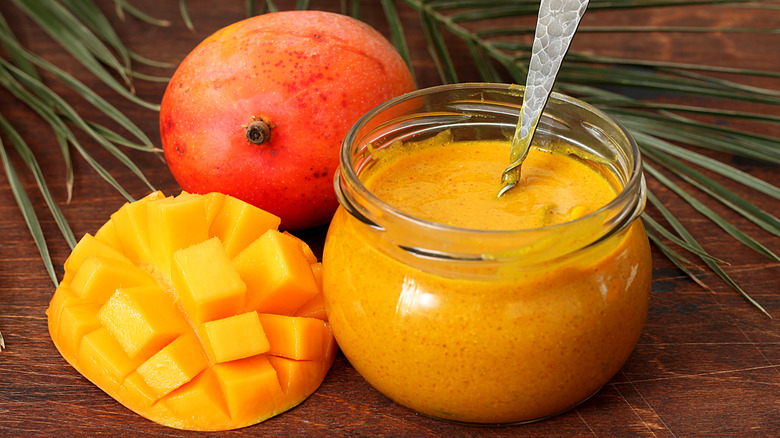The Middle Eastern Condiment Made With Pickled Mango
Often described as the Middle Eastern equivalent of umami, amba is a pickled mango condiment that crosses diasporic Jewish communities — from India to Iraq and Israel to Palestine (per Haaretz). The savory, sour sauce is equally loved both inside and outside the Green Line, which separates Israel from the West Bank and Gaza. However, the systemic racism of the Zionist movement meant that most of the Mizrahi Jewish culture was ostracized from mainstream Israel (via Ajam Media Collective).
Brought to Israel by Iraqi Jewish immigrants during the 1950s, per Food & Wine, amba continues to be marketed as authentically Iraqi or Indian, explains Ajam Media Collective. The discrimination that Iraqi Jews and other Jews with Middle Eastern ancestry faced throughout the history of the British occupation has led much of their culture to blend with that of the Palestinians — a cultural fusion exquisitely represented through the incorporation of amba in Palestinian shawarma shops, as well as in suburbs of Tel Aviv.
As the cuisines of the Near East expand into the culinary landscape of cities around the globe, amba can be found on the menus of modern Israeli, Middle Eastern, and Mediterranean restaurants alike — making amba a bright example of how important history, culture, and taste are to the food we eat.
History
Although amba spans far throughout the Middle East, it did not originate there. Amba has roots in India, and the story of how it made its way to the Middle East is one that Ajam Media Collective claims to be deeply connected to Mizrahi Jewish identity, or Jewish people with Middle Eastern ancestry (per My Jewish Ancestry). Despite Europe's control of Indian Ocean trade routes during the latter half of the 19th century, Mizrahi Jewish communities successfully established trading settlements across India. Through these routes, amba made its way to Iraq, which was once home to the largest population of Jewish people in the world, according to Food & Wine. And by the 20th century, you could find amba all over the capital city of Baghdad, per Ajam Media Collective.
Not long later, however, a political movement began, explains Ajam Media Collective. The Ottoman Empire collapsed in the aftermath of World War I and a group of European Jews known as Zionists aimed to establish a Jewish state in Palestine. Protests and riots ascended across the Arab World, largely targeting Mizrahi Jewish communities. Although most Mizrahi Jews had no interest in Zionism, many governments — including Iraq's — implemented laws targeting Jewish communities in the Middle East, ultimately driving them to emigrate. Mizrahi Jews were met with unforeseen xenophobia; Their culture and music were banned, and their food become the only way for them to preserve their culture.
For Iraqi Jews in Israel, one of those foods was amba.
How it's made
In Marathi, the language spoken in Maharashtra, India, the word "amba" literally translates to mango — the star ingredient in this tangy sauce (per Atlas Obscura). Starting with sliced green mango, the first step to homemade amba is fermenting the fruit. For the deepest flavor possible, the fruit is ideally allowed to ferment for at least five days. Then, the mango slices are left to dry in the sun, seasoned, simmered, and finally placed back in the fermentation jar to be used later. However, there are quicker ways to pull the sauce together. Lucy Simon's family recipe, as shared with Food & Wine, boils the mango in a mix of water and vinegar to ferment the fruit in a fraction of the time, giving you a luscious sauce in about an hour.
One of the benefits of making amba at home is the ability to personalize it with different seasonings. Traditional Indian versions of the sauce use fenugreek, turmeric, chili, and mustard seeds, per Atlas Obscura. However, some cooks prefer to elevate the flavors by incorporating tanginess, usually through the addition of vinegar and sour sumac, per Food & Wine. Garlic and cumin are sometimes used when savory flavors are preferred, while agave can be used for a touch of sweetness, as in the case of Lucy Simon's recipe.
Alternative textures can also be achieved — ranging from a smooth mango puree to a chunky, tender mango salsa-like consistency, depending on your taste.
How it's eaten
Tangy, spicy, and tropical — amba is a storm of flavors that adds brightness and complexity to the most simple of meals. According to Haaretz, amba was originally brought to Israel by Iraqi Jews to compliment Shabbat, the traditional breakfast of eggs and eggplant, and spread into Israeli and Palestinian cuisine over time. Throughout many parts of Israel (especially where Palestinian and Arab populations are dominant), food stalls offering shawarma and falafel typically serve amba as a condiment. It's very popular with sabich, the pita sandwiches stuffed with fried eggplant, hard-boiled eggs, tahini, and chopped salad (via Slurrp). Some people even dip their french fries into it, per Haaretz.
According to Atlas Obscura, it also pairs well with most proteins. Whether grilled with meat, seafood, or tofu, roasted with veggies, or mixed into labneh and made into a creamy dip, as Lucy Simon recommends to Food & Wine, the quintessential street food has evolved to be served in Mediterranean-style restaurants around the world. More sour than a mango chutney, with deep fermented flavors and spice, amba adds an exciting element that you'll be tempted to spread on everything and anything. Fair warning: it could become a habit — but who says that's a bad thing? We could all benefit from a little more amba.



